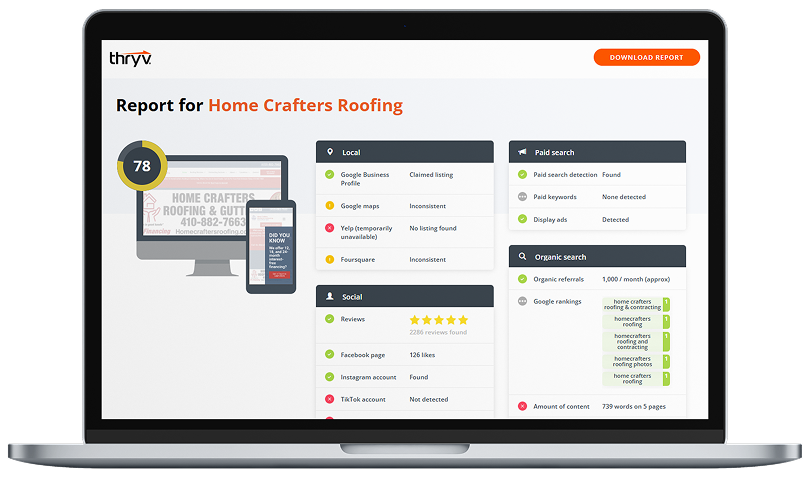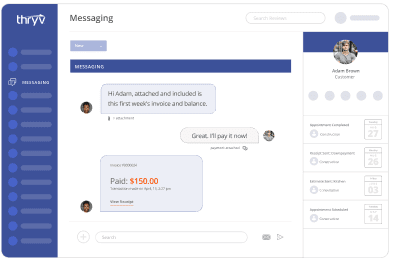At the start of the year, you may have mapped out goals, set key performance indicators (KPIs), and built a strategic plan for your small business. Now that you’re halfway through, it’s time to revisit and realign your strategy for success in the second half of the year.
Whether you’re seeing big wins or facing some challenges, the good news is it’s not too late to adjust, refine, and finish the year strong. Use this mid-year checklist to reassess your business strategy and get back on track or accelerate even faster toward your goals.
Mid-Year Performance Review Checklist
1. Revisit your annual goals and KPIs.
2. Evaluate financial health.
3. Audit marketing performance.
4. Check compliance.
5. Assess team performance and staffing needs.
6. Review and optimize tools and subscriptions.
7. Audit your website, SEO, and online presence.
8. Plan Q3/Q4 campaigns.
9. Declutter operations and streamline workflows.
10. Invest in professional development and networking.
1. Revisit your annual goals and KPIs.
Begin your mid-year review by revisiting the goals you set at the start of the year. Take a close look at where you stand. Are you making solid progress, falling behind, or perhaps even exceeding expectations? This is the time to measure your performance against the KPIs you established, whether they relate to revenue growth, new customer acquisition, lead conversion rates, website traffic, or other business-specific benchmarks. Analyze what the numbers are telling you. Ask yourself what specific strategies or initiatives are driving results. Are others underperforming despite the effort and investment? Use this insight to identify where your business is thriving and where there’s room for improvement.
And here’s an important reminder: if some of the goals you set back in January now feel out of reach or too easily attainable, it’s perfectly okay to adjust them. Market conditions shift, customer behaviors evolve, and internal dynamics change. Updating your goals based on current realities isn’t a sign of failure. It’s a smart, strategic move that keeps your business agile and focused on success.
2. Evaluate financial health.
Next, take a deep dive into your business’s financial health by reviewing your profit and loss statement, cash flow report, and current budget. These documents provide a clear picture of your business’s mid-year review performance, helping you determine whether your revenue and expenses are appropriately aligned.
Ask yourself these questions:
- Are you hitting your sales targets?
- Have any unexpected expenses impacted your margins?
- Are you managing cash flow in a way that supports both daily operations and long-term stability?
Now is also a good time to identify any spending leaks (recurring costs or unnecessary expenses) that may have gone unnoticed during the busier parts of the year. Tightening up your budget now can free up resources for other growth initiatives. Use this financial checkpoint to update your revenue forecasts based on actual performance from the first half of the year, and make sure you’re maintaining a healthy cash cushion to weather any surprises in the months ahead. Solid financial footing will give you the confidence and flexibility to move forward strategically in Q3 and Q4.
3. Audit marketing performance.
Take time to evaluate how your marketing efforts are performing across every channel you’re using, whether that’s your website, email campaigns, social media platforms, paid ads, or search engine optimization (SEO). Are your marketing campaigns delivering the leads, conversions, and visibility you anticipated at the beginning of the year? Have your SEO rankings improved, and are the right customers finding your business online?
To get a complete picture, focus on these key metrics:
- Website traffic and bounce rates: Measure how many visitors you’re attracting and how long they’re staying on your site. High bounce rates may signal that your content or user experience needs improvement.
- Ad performance and return on ad spend (ROAS): Analyze how well your paid ads are performing and whether you’re getting a strong return on your investment.
- Social media engagement: Track likes, shares, comments, and click-throughs to see which content resonates most with your audience.
- Email performance: Review open rates, click-through rates, and unsubscribe data to fine-tune your messaging and timing.
Once you have a clear view of what’s working, adjust your strategies accordingly. Shift time, energy, and budget toward the channels and tactics delivering the highest return on investment. Marketing is not a set-it-and-forget-it part of your business. It requires ongoing refinement, and a mid-year review will help you stay effective and competitive.
Market and Grow Your Business More Effectively With Marketing Center
Marketing Center helps you attract new customers to your business and shows you which marketing strategies work best for your customers so you don’t waste time and money on the wrong tactics.

4. Check compliance.
When business picks up and day-to-day demands increase, it’s all too easy to let administrative tasks fall by the wayside. However, staying on top of compliance is critical to avoid costly disruptions or penalties down the road. Take a moment now to thoroughly review your licenses and permits to ensure they are current and up to date. Operating without the proper legal authorization can lead to fines or even forced closures.
In addition, verify that you are on track with all tax obligations, including quarterly filings and payments. Missing deadlines or underpaying taxes can result in penalties and interest that quickly add up. Staying organized with your tax calendar and working closely with your accountant or tax advisor will help you maintain compliance and reduce stress.
Lastly, review contracts with your vendors, partners, and employees. Ensure that all agreements are up to date, accurately reflect the current terms, and continue to serve the best interests of your business. Sometimes, contract terms become outdated or no longer align with your evolving business goals. Renegotiating or updating these documents as needed will help prevent misunderstandings and protect your company’s legal and financial standing. Dedicating time to these administrative checks now can save you from bigger headaches later.
5. Assess team performance and staffing needs.
It’s essential to take a moment to assess your team’s overall performance as you enter the second half of the year. Are your employees in roles that best utilize their skills and strengths? Sometimes, a realignment or reshuffling can boost productivity and morale. Evaluate whether your current staffing levels are sufficient or if you need to hire additional team members to meet the increasing demand.
One effective way to gather this information is by conducting mid-year performance reviews or quick pulse surveys. These tools provide valuable feedback directly from your employees about their workload, challenges, and engagement levels. Listening closely can reveal opportunities to improve job satisfaction and identify any potential issues before they escalate.
A key reminder: don’t wait until signs of burnout or turnover appear before addressing staffing needs. Proactively planning your workforce strategy now ensures that your team remains motivated, capable, and ready to drive your business through the busy months ahead.
6. Review and optimize tools and subscriptions.
Take a careful look at the digital tools and software subscriptions your business is currently paying for. With numerous options available, it’s easy to accumulate services over time that may no longer provide the value they once offered. Now is the perfect time to evaluate whether each tool is still helping you work smarter and more efficiently.
Begin by examining the tools you use daily, such as your CRM and email marketing platform. Are they actually helping you manage leads, stay connected with customers, and effectively convey your messages? Then check in on your scheduling and invoicing tools. Are they making things easier, or just adding more steps? Take a moment to see how your project management software is working for your team—are people using it to stay organized and on the same page? And don’t forget your marketing automation tools. Are they doing their job by saving you time and keeping your outreach running smoothly? If not, it might be time for a change.
Once you have a clear picture, don’t hesitate to cancel subscriptions that aren’t delivering value. Redirect that budget and focus toward the tools that truly support your business goals and contribute to growth. Optimizing your technology not only saves money but also enhances overall productivity, ensuring your operations run smoothly.
7. Audit your website, SEO, and online presence.
Your website is often the first impression potential customers have of your business, so it’s crucial to keep it well-maintained. Start by ensuring your site is up to date with current content, loads quickly, and provides a seamless experience across all devices, especially mobile. In today’s world, a slow or difficult-to-navigate website can quickly turn visitors away. Additionally, double-check that your business listings across online directories are accurate and consistent, as these play a vital role in helping customers find you easily.
To further boost your online presence, conduct a thorough SEO audit. Begin by scanning your website for broken links and outdated content that could harm your search rankings and frustrate visitors. Next, review your page titles and meta descriptions to ensure they are clear, compelling, and contain the keywords your target audience is searching for. Finally, verify that your site is ranking well for the most relevant keywords in your industry, as this will help attract qualified traffic and improve your chances of converting visitors into customers. Regularly maintaining and optimizing your digital presence with a mid-year review ensures your business stays visible, credible, and competitive online.
8. Plan Q3/Q4 campaigns.
Begin planning your promotions, content, and special offers for the remainder of the year well in advance to ensure a smooth and successful execution. This planning should include key seasonal opportunities such as back-to-school campaigns and holiday promotions, which are often major drivers of customer interest and sales. Incorporate seasonal content that resonates with your audience during these specific times to keep your messaging fresh and relevant.
In addition to these, outline lead-generating campaigns designed to attract new customers. Don’t forget to include initiatives that encourage existing customers to return, such as referral programs or loyalty rewards that incentivize repeat business and foster brand loyalty.
By mapping out these strategies now, you give yourself ample time to create quality content, coordinate your marketing efforts, and build momentum, avoiding the stress and last-minute rush that can undermine effectiveness. Thoughtful preparation will help you capitalize on key opportunities and finish the year strong.
Market and Grow Your Business More Effectively With Marketing Center
Marketing Center helps you attract new customers to your business and shows you which marketing strategies work best for your customers so you don’t waste time and money on the wrong tactics.

9. Declutter operations and streamline workflows.
Now is an ideal moment to take a close look at your daily operations to identify areas where efficiency can be improved. Consider whether there are repetitive tasks that could be automated. Also, look for bottlenecks or delays that may be slowing down your service or causing frustration for your team and customers.
To streamline your operations, start by creating clear and detailed Standard Operating Procedures (SOPs) that outline each step of your key processes. SOPs help ensure consistency and make training new team members easier. Next, explore opportunities to automate routine tasks such as follow-up communications, invoicing, and appointment scheduling. Automation not only speeds up these processes but also frees up your team to focus on higher-value work. Lastly, evaluate your communication tools and consider consolidating them into fewer platforms to reduce confusion, improve collaboration, and keep everyone on the same page. By optimizing your workflows now, you’ll create a smoother, more productive operation that supports growth and enhances customer satisfaction.
10. Invest in professional development and networking.
Successful businesses are driven by leaders who are committed to continuous growth and development. Investing in your professional development is one of the most impactful ways to ensure your business thrives. Consider attending industry conferences where you can learn about the latest trends, gain new skills, and connect with experts. Enrolling in workshops or certifications relevant to your field can deepen your knowledge and expand your capabilities, helping you stay competitive.
Joining local networking groups or small business organizations provides valuable opportunities to build relationships with peers, share insights, and collaborate on solutions to common challenges. Additionally, seeking out mentorship can offer fresh perspectives and guidance as you navigate your entrepreneurial journey. Remember, growth doesn’t just happen within your business; it also happens through your development as a leader. By investing in yourself, you lay a solid foundation for long-term success.
Mid-Year Review Example
Below is a sample mid-year review for a small business, illustrating how to effectively evaluate progress and adjust plans. This example is for a fictional neighborhood coffee shop.
|
Introduction: As we reach the midpoint of 2025, Brew & Bean Cafe is reviewing its progress toward increasing local foot traffic and boosting customer loyalty through targeted promotions and community events. This review summarizes key metrics, financial health, marketing results, staffing insights, and operational improvements to inform adjustments for the second half of the year. |
|
Goals & Objectives: Increase monthly in-store customer visits by 15% (baseline = 1,200 visits/month as of January 2025). Grow loyalty program membership by 25% (baseline = 800 active members). Boost social media engagement by 40% (measured by combined likes, shares, and comments across Instagram and Facebook). |
|
Performance Review: Customer Visits: Average monthly visits grew by 10% through May, slightly behind target but trending upward thanks to weekend events. Loyalty Program: Membership increased by 18%, with strong sign-ups during March and April promotions. Social Media: Engagement increased by 35%, with Instagram Stories generating the highest number of interactions. |
|
Financial Health: Revenue increased 12% compared to the same period last year. Unexpected supply cost increases (up 8%) resulted in a slight reduction in gross margin. Cash flow remains stable, with a reserve fund covering two months of operating expenses. |
|
Marketing & Promotions Audit: Local event sponsorships have positively impacted foot traffic. Paid social ads delivered a 3:1 return on ad spend, prompting plans to increase the budget. Email open rates dipped slightly; content refresh and segmentation are planned for Q3. |
|
Staffing & Operations: Staff schedules adjusted to better match weekend demand peaks. Two new baristas were hired in May to improve service speed during busy hours. A new POS system integration is underway to streamline checkout and inventory tracking. |
|
Compliance & Administration: All health and business permits were renewed on schedule. Quarterly tax filings completed without issues. Vendor contracts have been reviewed; negotiations are underway for improved coffee bean pricing. |
|
Next Steps & Adjustments: Revise customer visit goal to 18% growth, reflecting stronger event performance. Expand loyalty program perks to encourage repeat visits and referrals. Increase social ad spend by 20% with a focus on video content. Launch the email marketing refresh by mid-July, targeting specific segments. Continue operational streamlining with full POS rollout in August. |
|
Key Performance Indicators (KPIs) to Monitor: Monthly in-store visits (goal: +18% by December 2025) Loyalty program active members (goal: 1,000+) Social media engagement rate (goal: +40%) Gross margin percentage (goal: maintain or improve despite cost pressures) |
This example illustrates how a small business can utilize mid-year data to measure progress, identify areas that require adjustment, and develop an actionable plan to successfully conclude the year.
Finish Strong: Turning Insights into Results
The mid-year point isn’t just a checkpoint, it’s a launchpad. Whether your business is ahead of plan or needs a course correction, this review provides the clarity and direction you need to move forward with purpose. By taking the time to evaluate your goals, finances, marketing, operations, and team performance, you’ve gathered valuable insights into what’s working and where there’s room to grow. Now it’s time to act. Refine your strategy, reallocate resources, and reinvest your energy into the tools, people, and processes that drive results.


